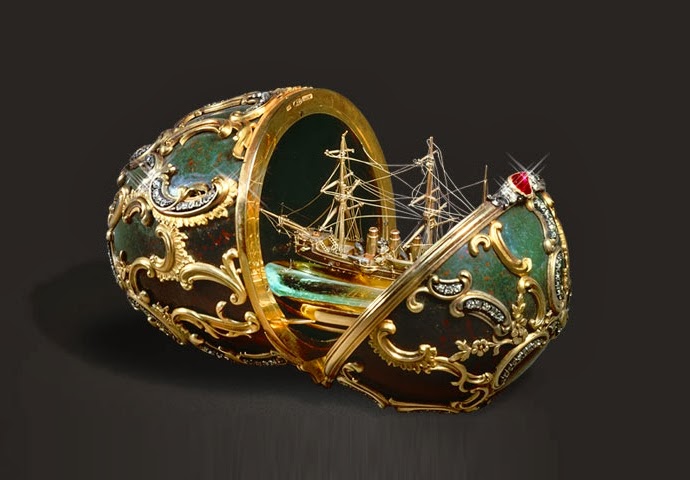18th February 2014 - 18th May 2014
www.khm.at
As part of the Russian-Austrian Cultural Season the Kunsthistorisches Museum Vienna presents the work of Carl Fabergé, probably Russia’s leading and most influential jeweller and goldsmith at the turn of the 20th century.
The name Fabergé conjures up exceptional creations, virtuoso craftsmanship that combines outstanding artistic and technical skill with the finest materials. This is particularly true of the work produced by Peter Carl Fabergé following his appointment as court jeweller to the last Russian Tsar in 1885. Under him the House of Fabergé grew into one of the largest contemporary jewellery companies, at times employing over five hundred goldsmiths, stone cutters and jewellers from different countries. The company worked for the imperial Russian court and other European dynasties, for the nobility, plutocrats and financial magnates, but they also produced less exalted work designed for the Russian bourgeoisie.
Over 160 loans from the Kremlin Museums and the Fersman Mineralogical Museum in Moscow showcase Fabergé’s virtuosity, placing him in the context of contemporary Russian goldsmith work; another focus is the role of the imperial family. Four Imperial Easter eggs form the centre of the show - precious objets d’art commissioned by the Imperial family that frequently contain a world en miniature, a microcosm. Other artefacts that once belonged to members of the House of Romanov, treasured possessions that stayed with them until their final days, offer fascinating insights into life, both private and ceremonial, at the imperial court. We also showcase hardstone carvings by Fabergé and the imperial manufactories at Petergof and Yekaterinburg, documenting the continued popularity in late-nineteencentury Russia of an art form closely connected with Kunstkammer collections.
And, last but not least, Fabergé’s multi-facetted oeuvre is juxtaposed with the work of other Russian imperial jewellers such as Bolin, Carl Blank, Pavel Ovchinnikov or Ivan Khlebnikov, inviting visitors to enjoy and appreciate the outstanding technical and artistic virtuosity of late-nineteenth-century Russian jewellers, first celebrated in 1873 at the World Fair in Vienna.
www.khm.at
As part of the Russian-Austrian Cultural Season the Kunsthistorisches Museum Vienna presents the work of Carl Fabergé, probably Russia’s leading and most influential jeweller and goldsmith at the turn of the 20th century.
The name Fabergé conjures up exceptional creations, virtuoso craftsmanship that combines outstanding artistic and technical skill with the finest materials. This is particularly true of the work produced by Peter Carl Fabergé following his appointment as court jeweller to the last Russian Tsar in 1885. Under him the House of Fabergé grew into one of the largest contemporary jewellery companies, at times employing over five hundred goldsmiths, stone cutters and jewellers from different countries. The company worked for the imperial Russian court and other European dynasties, for the nobility, plutocrats and financial magnates, but they also produced less exalted work designed for the Russian bourgeoisie.
Over 160 loans from the Kremlin Museums and the Fersman Mineralogical Museum in Moscow showcase Fabergé’s virtuosity, placing him in the context of contemporary Russian goldsmith work; another focus is the role of the imperial family. Four Imperial Easter eggs form the centre of the show - precious objets d’art commissioned by the Imperial family that frequently contain a world en miniature, a microcosm. Other artefacts that once belonged to members of the House of Romanov, treasured possessions that stayed with them until their final days, offer fascinating insights into life, both private and ceremonial, at the imperial court. We also showcase hardstone carvings by Fabergé and the imperial manufactories at Petergof and Yekaterinburg, documenting the continued popularity in late-nineteencentury Russia of an art form closely connected with Kunstkammer collections.
And, last but not least, Fabergé’s multi-facetted oeuvre is juxtaposed with the work of other Russian imperial jewellers such as Bolin, Carl Blank, Pavel Ovchinnikov or Ivan Khlebnikov, inviting visitors to enjoy and appreciate the outstanding technical and artistic virtuosity of late-nineteenth-century Russian jewellers, first celebrated in 1873 at the World Fair in Vienna.
